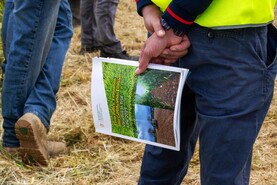Barley yellow dwarf virus infection is likely not as bad as it looks. Spring cereal crops are heading out in many places now and the yellow leaves of barley yellow dwarf virus (BYDV) infection speckled across cops is starting to fade away.
In recent weeks those yellow leaves looked very bad in many crops, but it is likely that the infected leaves looked a lot worse than the infection that was there.
Speaking at the Goldcrop open day, John Dunne explained that if there are 300 plants in 1m2 and 3 plants are infected then that is only 1% infection and the effect of that on yield is equivalent to the cost of the aphicide spray.
However, BYDV is becoming a bigger issue in winter cereals due to bad weather and different infection timings and in spring crops where planting is delayed.
Genetic tolerance to BYDV in spring barley is on the way, but it’s a bit away John noted. There are a number of BYDV tolerant varieties in winter barley, while research into tolerance and resistance in wheat is underway.
Genserus
Genserus from RAGT seed breeders stands for Genetic Security Virus. It aims to produce varieties that are resistant to barley yellow dwarf virus (BYDV).
At the Goldcrop trial site in Co Cork wheat plots were being examined for their performance with these genetics. Trials manager John Dunne explained that wheat with these resistant genes can be infected with BYDV, but the virus won’t replicate in the plant. This means that the level of virus will be about 10% compared to a variety which does not carry resistance.
This season many wheat varieties were badly affected by BYDV as they were not sprayed with an aphicide in the wet autumn and winter.






 This is a subscriber-only article
This is a subscriber-only article










SHARING OPTIONS: